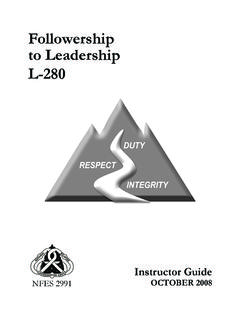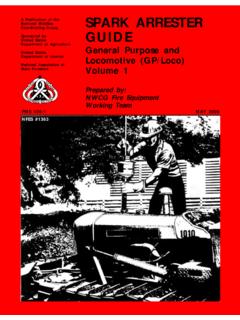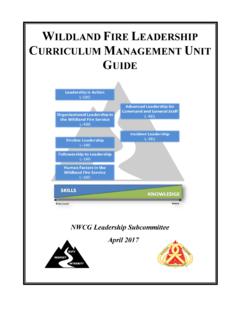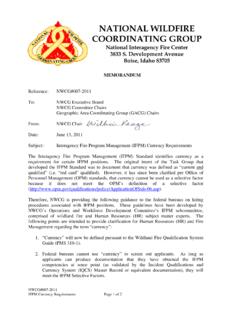Transcription of Annual Safety Refresher Guidelines - tncfiremanual.org
1 1 Annual Safety Refresher Guidelines for Nature Conservancy Fire Programs The Nature Conservancy, November 2014 nwcg protocols require Annual Safety refreshers for fire personnel. The purpose of this document is to provide guidance for Conservancy staff on this issue. This course is now known as RT-130 Annual Fireline Refresher Training (Details can be found in the nwcg document PMS 901-1, Field Manager's Course Guide.) Who must participate in an Annual fireline Safety Refresher ? All personnel who may be directly involved in fire suppression or prescribed fire activities must participate. You should interpret this to mean that all crew members must attend the Safety Refresher (see below for information on newly trained crew members). Those persons that might be present on a fire that are not part of the crew, such as photographers, communications specialists, your state director, etc.
2 , need to be accompanied at all times by a trained crew member who has participated in an Annual Safety Refresher . Who can lead a Safety Refresher ? Lead instructors must be a qualified Single Resource Boss. Unit instructors must be qualified as Firefighter Type 1 (FFT1). Adjunct instructors may be utilized to provide limited instruction in specialized knowledge and skills at the discretion of the lead instructor. They must be experienced, proficient and knowledgeable of current issues in their field of expertise. What material should be included? Four objectives are covered in the training: Entrapment Avoidance (Risk Management from your IRPG, LCES, Standard firefighting Orders, etc.); Current Issues (such as those found at WFSTAR, or Safety and risk issues identified within the program during the past year); Fire Shelter (includes review of fire shelter use, inspection and a timed deployment of a practice shelter); and Other Hazards and Safety Issues.
3 Note- live fire is not acceptable in training environment for fire shelters. Other Hazards and Safety Issues should focus on Safety issues pertinent to the local program. There are many good resources available through the nwcg and other web sites for use in the Annual Refresher , including talk outlines for specific topics, videos, and printed materials. The important thing is that the Refresher be designed to fit the needs of your program. Different agencies require slightly different components to the Refresher , so keep this in mind if your Refresher will be conducted in cooperation with partners. While you have your crew together is also a good time to administer the Work Capacity Test ( Annual fitness testing). However, the Work Capacity Test is different from the RT-130 Safety Refresher course.
4 A certificate of completion for RT-130 does not indicate successful completion of fitness testing. And record of passing the Annual fitness test (Moderate or Arduous level) does not indicate completion of RT-130. Conservancy fire supervisors will ensure Annual staff completion of both. 2 How many hours of contact time is required? The Nature Conservancy requires four hours minimum course length. Up to two hours of the four required may be covered through pre-work. Instructors must ensure all core topics will be covered. Time required to complete Work Capacity Tests should not be counted toward RT-130 minimum course length. US federal agencies require varying minimum course length for RT-130, so consider this if you are including partners in your training. Some agency specific Guidelines on contact hours (from NFES2724, Jan 2014) BLM - 4 hours FWS/FS - No minimum hourly requirement; core topics as shown above will be covered.
5 NPS - 8 hours Can we use home study/reading to accommodate some of this time? Pre-work such as reading of material or viewing content found at WFSTAR can provide excellent context or background material for further discussion in classroom or other training environment. Up to two hours of the minimum required four hours may be covered through pre-work. You must document that this study has taken place (content and date). Materials must be provided or compiled by the lead instructor of the Refresher who will ensure student accountability for exposure to the material. Can the Safety Refresher include a field component? A field component can provide a valuable Safety Refresher experience. Make sure your focus includes at minimum the four course core topics. Don t try to conduct a burn at the same time you need to concentrate on the Safety topics without the distraction of live fire.
6 A burn after your Safety Refresher is completed is acceptable. Where can I find resource materials? Wildland Fire Safety Training Annual Refresher web site, found at WFSTAR. Experiential Training Will attending a Safety Refresher hosted by another organization fulfill the requirement? Yes, as long as it complies with minimum requirements listed above. Can attending or teaching S-130/S-190 substitute for the Refresher ? Yes. If you have crew who just completed basic firefighter training (S130, S190, I-100, L-180), they do not need the Annual Safety Refresher until one year following the basic training. Instructors at the S-130 /S-190 course session may also use this experience as their Annual Safety Refresher , provided they were involved in covering Safety topics, and participated in fire shelter review and deployment.
7 How do we document fire personnel attendance at the Safety Refresher ? You must maintain a list of all personnel that attend the Refresher each year, along with that year s agenda. Each crew member should add the Refresher to their own training log. You may need to send a memo to another organization if one of their personnel attends your Refresher , or request a memo from them if one of your personnel attends their Refresher . Your memo should list the number of contact hours and topics covered. Training certificates for RT-130 can be issued provided instructors are qualified (SRB for lead instructor and FFT1 for unit instructors), minimum contact times are followed, and all four core topics 3 have been covered, including practice shelter timed deployment. The instructor(s) may also be granted certificate(s) of completion as long as they participate fully and complete all course requirements, including practice shelter deployment.
8 How do we provide data on the Safety Refresher attendees in order to receive Incident Qualifications Cards (aka. red cards)? If your staff or volunteers require IQ Cards you must send information on the date of the Safety Refresher and date of passing the fitness test to your Fire Manager, who will verify the information and send it to their supporting IQCS Database Coordinator.






